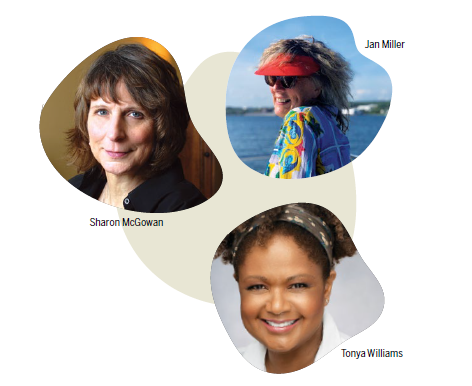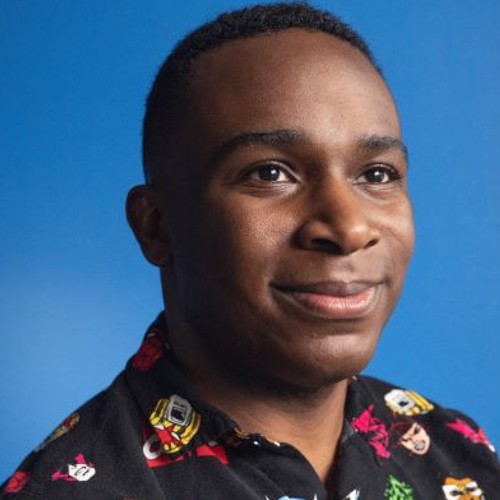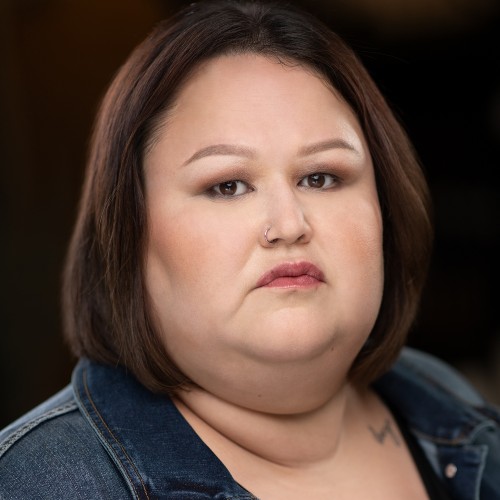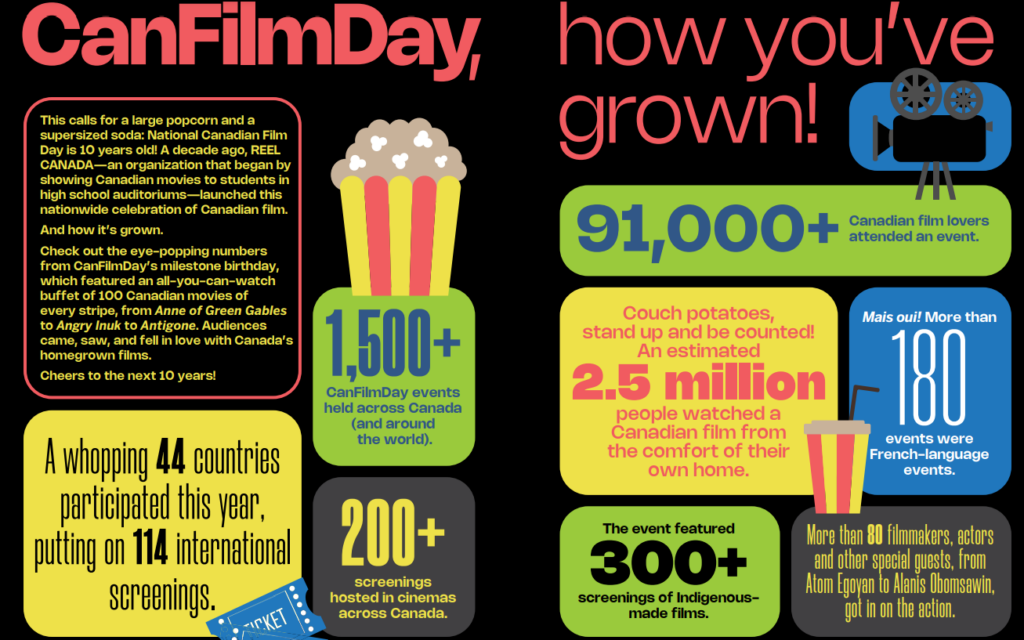Category:
Geena Davis Institute celebrates 20 years of tackling sexism on screen
Geena Davis Institute celebrates 20 years of tackling sexism on screen
Two decades in, the Geena Davis Institute is inspiring Canadian groups such as Reelworld and Women in View to tackle representation on screen using hard data
“When we don’t look at who is behind the camera… we’re taking for granted the fact that the narrative is culturally a singular narrative that is not representative of the total Canadian population.”
This year’s WIVOS Report is its seventh iteration, having led the charge in national on-screen equity reporting in its previous six reports. “Data is hugely influential in addressing change,” says Jan Miller, board member of Women in View. Miller is also part of the WIFT (Women in Film and Television) Canada Coalition, as well as a founding member of the National Screen Institute of Canada (NSI).
“Each time the report came out, it influenced change. What started to happen was other agencies started to recognize the value of the numbers and the value of the statistics. And so they began their own reporting,” she reveals.
Key research points in previous reports include the monetary investment in women’s stories, the percentage of films produced by women, and— of that percentage how many were produced by white women versus Black or Indigenous women. Positive change started to trend as a result.
But if the findings indicate a trend toward less equity in the industry, does the industry call itself out for not doing the work? And if so, how do we move forward?
Tonya Williams has been doing that work with Reelworld Screen Institute for 23 years. The Toronto-based not-for-profit’s mission is “to advance opportunities for Canadians who are Black, Indigenous, Asian, South Asian, and People of Colour in the screen industries by providing professional development and advocating for racial equity in Canadian content and production.”

Reelworld is just now releasing the BIPOC protocols guideline for addressing the depiction of Black, Indigenous, Asian and women of colour in Canadian screen content. The research project informing the protocol guideline is called Her Frame Matters.
Williams, who played Dr. Olivia Winters on The Young and the Restless from 1990 to 2012, continually noticed she was the only Black person in a room at any given time—in drama school, at auditions, at roundtable discussions.
“All of these instances reinforced to me that, ‘You are an anomaly to the rule,’” Williams says. “It’d be an audition filled with white people and I was the only Black person. So I pretty much felt the confidence that I was getting the role of the Black person.”
Safia Abdigir, a researcher for Her Frame Matters, says they wanted to collect the data, look at historical depictions of BIPOC women, and then create best practices and an outline on ways to move forward.
“When we are requesting shifts in the industry, the ‘why’ is asked,” says Abdigir.
“Having the data and research is important to be able to prove it and to show exactly the issues that we’re dealing with. If we’re not really specific about what the issues are, we can’t really be specific about moving forward in terms of recommendations.”
On Her Frame Matters, Reelworld conducted content analysis on a combination of films and TV series on their depictions of women, including what the roles were, how long they were on screen, whether they pushed the plotline forward, their role in the story, and particular ways in which they were sexualized or not sexualized.
What all three institutes have in common is threading together the story that data and research tell.
“I’m looking forward to the phase where we get down to the really hard work of recognizing all the systemic problems in the entire structure of our industry,” says Williams, “and how we can, slowly, over the next 20 years, create a strategic plan, where we can see the data means things are improving or not improving.”
For Di Nonno and the work done at the Geena Davis Institute, women seeing themselves represented is key—and now they have the data to back it up.
“We want to see ourselves in the stories that we’re watching. When we see ourselves, we get the message that, well, maybe I can do that. For example, in Hidden Figures… all of those young Black girls seeing that story and saying, ‘Wow, you know, I could send somebody to the moon!’” she says.
In fact, one of the institute’s 58 key findings includes a data point that proves just that. It’s called the Scully Effect, referencing the character of Dana Scully from The X-Files, played by actor Gillian Anderson.
“They actually asked us to validate that, and we found that 63 per cent of the women who are currently working in STEM were inspired by her,” confirms Di Nonno.
“That’s amazing. That’s real-world impact.”

France Martin hits the ground running
France Martin hits the ground running
The new Executive Director of the Youth Media Alliance takes her positive attitude to a sector in flux: “This industry can go as far as it wants”
France Martin hasn’t been on the job very long—she assumed the role of Executive Director of the Youth Media Alliance (YMA) in April 2023. She’s also a newcomer to the screen industry, though she comes armed with plenty of executive experience in the non-profit sector, leading organizations from the Canadian Kinesiology Alliance to the Fondation des Offices jeunesse internationaux du Québec.
Still, she didn’t need much time to recognize that “change” is the watchword for Canada’s media industry in general, and youth media industry in particular. Seismic platform shifts. Bill C-11. The double-edged promise of AI.
“The industry is going through major transformation,” Martin says. “Just think of the outstanding quantities of new material now available to children. How can creators and producers make something that stands out from the group and gets selected by children or their parents?”
At YMA, it’s Martin’s mission to help producers do just that. Through advocacy, scholarship funds, an awards gala, and lowering barriers to access for different festivals, YMA is committed to ensuring that quality Canadian children’s content continues to get made.
To be sure, the obstacles are myriad. Martin mentions the crowded field of distribution channels, from traditional broadcasters to streamers to platforms like YouTube and TikTok. Says Martin, “We’re faced with the challenge of making sure there is Canadian content on streaming services, for example. And how do we get streamers involved in our associations and our industry and with our stakeholders?”
One way she is tackling this specific challenge is by assuming the role of a host at a party: doing her best to ensure that everyone knows everyone else. “We make sure that we’re in touch with the big names, and in turn, we put them in touch with our producers,” she says. This is the first step toward filling the production pipeline with high-quality kids’ content.
And while Martin sees geographical boundaries dissolving in the way that shows get produced— she mentions, as an example, a Montreal producer who’s making a series with a team assembled from three separate countries— YMA is dedicated to supporting the production of distinctly Canadian content.
“We are a Canadian organization,” she says, “and our priority is helping Canadian creators.”
In the short time she’s been at the helm of YMA, it seems Martin has already developed a key focus: improving access to content for children. This means bringing the content to the audience, rather than the audience to the content, and making that content visible around every corner, from YouTube to traditional TV.
“The best strategy is to be on many platforms at a time,” says Martin. “If I were to define success in five to seven years, it would be that whatever is produced, children and families are accessing it in as many ways as possible, for their entertainment and their education.”
Of course, in such a rapidly changing environment, it’s hard to make predictions about the next five months, let alone the next five years. It’s a thought that energizes Martin: “There’s major transformation coming along, and we are adjusting as we go. There is so much creativity and positivity in our sector, and so many new technologies, from animation to live action to video games. I think that’s fabulous. And in five or seven years, we can have this discussion again, and we’ll look back and say, ‘Wow. Where were we way back then?’
“This industry can go as far as it wants.”
Breaking down the barriers
Breaking down
the barriers
A conversation with Winnie Luk, Executive Director of the Disability Screen Office
The Disability Screen Office (DSO) has a two-pronged mandate: the organization works to eliminate accessibility barriers and foster meaningful disability representation within the Canadian screen sector. Earlier this year, the DSO hired Winnie Luk as its new (and first) Executive Director. Luk has embraced her new role with extraordinary enthusiasm. She shares with Indiescreen why she is tailor made for this role, and outlines her plans to break down barriers to accessibility and representation for the disability community.
“Everyone will experience some type of disability in life,” says Luk, “whether by accident or aging. If you’re not invested in accessibility, you’re not doing yourself any favours.”
What were you doing before you stepped into this role at the DSO?
I started this role in June, and it actually felt very fateful when I was hired, because of my work history. Before and all through university, I was working in accessibility programming with the City of Toronto, and after graduating, I took a position with Inside Out, the queer film festival. Inside Out was essentially my dream job and my dream organization, and I got to work there for more than 15 years. I was the director of operations when I left to work as managing director for Rainbow Railroad, which was in its start-up phase at that time. Rainbow Railroad is a charity non-profit organization that helps persecuted LGBTQI+ individuals around the world escape violence.
That sounds like very serious stuff.
Very serious stuff. I spent a really incredible four years building up that organization, but faced burnout in a sector where my work really was life and death. So I was taking some time off to explore what I wanted to do next when I saw the DSO posting for their first ever executive director. I was attracted to the fact that the DSO is a very new organization, because I’m a builder—I build organizations. When I was hired, I reflected back on my career and everything I had done, and thought, Wow. Every choice I made, every move I made really made me perfectly suited for this role, especially the last four years working in human rights.
Being the leader of a brand-new organization sounds exciting— but also daunting. What are your first priorities?
The first few things that I’m planning to do are solidify our strategic plan, complete our communications plan, and build the actual infrastructure for the organization. Obviously getting sustainable funding is a priority, and not just programming funding, but operations funding. I understand that programming is very sexy and everyone wants to support programming, but if you don’t have a solid infrastructure then the programs and everything else don’t have a solid foundation. I cannot say enough about how important sustainable, unrestricted funding is to a new organization, to set it up successfully and on the right footing.
How would you gauge the response from the industry to the DSO so far?
Since day one, I’ve been meeting with folks and organizations, including other equity-seeking organizations, to think about collaborations and partnerships. I’ve been meeting so many incredible new people, organizations, businesses, corporations—everyone within the sector has been welcoming, supportive, encouraging, and really wanting to get involved in the work. We’re at this tipping point right now, where everyone agrees that change is needed. And it’s not needed presently, it was needed a long time ago. The screen sector is quite behind in disability matters, and people know it. And if you are not with us right now, you are going to fall even further behind.
Can you talk a bit about what the DSO is trying to achieve?
We’re working on two things: accessibility is about breaking down barriers, it’s a human right, it’s law. But then there’s representation when it comes to visibility as well, in front of and behind the camera. We’re going to provide the guidelines and standards and protocols for working with the disability community, but we also believe there should also be some real accountability. That’s where our production disability coordinator training comes in (see sidebar).
We need to be thoughtful and work with people who have experience. I know there’s a workforce shortage right now; that’s a huge opportunity. The sector can welcome in folks who are willing and ready to work, and make use of their innovation and their creativity—because people with disabilities have had to constantly adapt, because of the barriers they’ve faced. Imagine the skills, the knowledge, the learning that this community has. Imagine how the sector can benefit from that.
What the DSO is working on
In order to increase accessibility within the screen sector, the DSO has three initiatives it’s planning to launch this year:
1) Develop guidelines to help the screen sector work with the disability community. The first phase of this project will focus on data collection, “because there’s so little data out there, and what is out there is not necessarily accurate, since divulging disability is hard for people—they still feel stigma, and there are a lot of barriers to talking about it,” says Luk.
2) Create a centralized industry resource centre. Luk calls this project “a one-stop shop for everything disability related in the screen sector”: from crew to venues to accessible services. “My inbox is filled with inquiries about disabled creatives, workers, actors, and on the other side, people needing to find assistive technology services, interpreters, open captioning services. We want to be that place that everyone knows to come to and get linked up to whatever they’re needing,” Luk says.
3) Train accessibility coordinators to work with the screen sector. Luk believes that accessibility commitments are fantastic first steps, but accessibility coordinators on set can bring accountability and ensure productions are meeting those commitments. “There’s already an immense group of people who have the skills and knowledge, who just need opportunity,” says Luk. “There should be some real accountability in the sense of what it means to be accessible, and truly disability led.”

They got next
They got next
Checking in on recent alumni of the CMPA mentorship program
Nic Altobelli

MENTOR: Sara Blake (Ceroma Films)
HIGHLIGHTS FROM YOUR MENTORSHIP EXPERIENCE?
Attending the Berlinale Market online and learning more about international co-productions.
WHAT ARE YOU WORKING ON RIGHT NOW?
I am in the 2023 cohort of the CFC Producers’ Lab, collaborating to create a film that will hit the festival circuit later this year. My MPPIA Award–winning short film My Roommate Ahriman will premiere at the Whistler Film Festival. As well, I’m participating in the GEMS Genre Film Lab to pitch our feature film, Mt. Asha, at Frontières Film Market. I also have a few TV series on my slate!
WHERE WILL YOU BE IN 10 YEARS?
Running a mid-sized production company, producing media that subverts human struggle through engaging, diverse characters and dynamic stories. At the tables where important conversations are happening around where the industry is headed and what needs to change.
Malachi Ellis

MENTOR: Shant Joshi (Fae Pictures)
HIGHLIGHTS FROM YOUR MENTORSHIP EXPERIENCE?
Attending industry events such as Prime Time. I made incredible connections and bonded with other mentees and emerging producers.
WHAT ARE YOU WORKING ON RIGHT NOW?
I am currently a resident of the CFC’s Norman Jewison Film Program Producers’ Lab. I have two feature film projects in development, and my short film, Express, will begin its festival journey this September.
WHERE WILL YOU BE IN 10 YEARS?
Creating my own MCU: the Malachi Cinematic Universe. This MCU will feature stories of identity and self-discovery from talented Canadian voices, both in the feature film and television space.
Linda St. Pierre

MENTORS: Marie Clements, Trish Dolman, Christine Haebler, Suz Thompson (Marie Clements Media, Screen Siren Pictures)
ANY HIGHLIGHTS FROM YOUR EXPERIENCE?
Seeing Bones of Crows come together and walking the red carpet at VIFF. The story hit home, as it’s based in Manitoba, where I’m from and where my family would have attended residential school.
WHAT ARE YOU WORKING ON RIGHT NOW?
My company, Phoenix Skye Productions, is in pre-production for two short films: Choices, which was selected by TELUS STORYHIVE Indigenous Storyteller Edition, and an animated documentary short called Bet’sune Yinesha (His Grandmother Raised Him), which will be filmed in Lac Brochet, Manitoba. It will be told by my elders in the Dene language, and I’ll be directing as well.
WHERE WILL YOU BE IN 10 YEARS?
A powerhouse writer, actor, producer and director, sharing my Dënesųłiné language through TV and films, and making more Indigenous stories.
CanFilmDay, how you’ve grown!
CanFilmDay, how you’ve grown!
This calls for a large popcorn and a supersized soda: National Canadian Film Day is 10 years old!

Now is the time
Now is the time
A conversation with Julie Roy, Executive Director and CEO of Telefilm Canada
Julie Roy knows Canada’s film production sector like the back of her hand. With nearly 20 years of experience at the National Film Board (most recently as Director General of Creation and Innovation), the acclaimed producer was a shoo-in as Telefilm Canada’s new Executive Director and CEO, a role she took on in April 2023. Her appointment comes at a time of great change, excitement and (as always in this industry) uncertainty in the sector, but she’s undaunted by the challenges ahead—and inspired by this country’s glowing reputation on the international scene. “People are watching us, and they are interested in us,” says Roy. “Now is the time to strategize for the future.”
You’ve been at Telefilm Canada for a few months now. What has been the biggest surprise?
During my time at Cannes, I was captivated by Telefilm’s well-established reputation abroad with international funders, like Eurimages and New Dawn, as well as with organizations like Centre national du cinéma and Screen Australia, among others. Also, witnessing firsthand the rapport that Telefilm has forged with Canadian producers and talent gave me great delight. I am fascinated by the exemplary status that Canada and Telefilm’s reputations hold across the globe. People are watching us, and they are interested in us. This extraordinary web of connections that Telefilm possesses fosters invaluable exchange networks, allowing us to tackle shared challenges in our respective countries. Together, we can work on the evolution and transformation of the audiovisual industry.
You enjoyed a long career at the National Film Board. What learnings from the NFB can you apply to your role at Telefilm?
As a long-standing supporter of filmmakers and a champion of the creative process, I carry a profound appreciation for its intricacies. Through my extensive experience as a producer, executive producer and Director General of Creation and Innovation, I’ve learned the art of decision making. This delicate exercise requires honesty, respect for artists, and the courage to stand by our choices. Working in public service entails significant responsibilities, such as managing public funds with prudence and setting exemplary standards. Rigour and competence are paramount. My various roles at the NFB also taught me that as a public organization, we wield considerable influence within the industry. It is important to use this influence wisely. In recent years, I actively championed our diversity, equity and inclusion initiatives, firmly believing in the power to effect change from a position of influence. This wealth of expertise and learning is valuable to Telefilm. I envision Telefilm as an influential leader, with a robust plan to fulfil our goals on EDI along with our commitments to environmental responsibility. The time for collective action and tangible impact is now.
Audience viewing habits have evolved rapidly in the past five years. Streaming services and the pandemic have contributed to a marked decline in theatrical viewing. How does Telefilm balance funding for theatrical release and helping filmmakers meet audiences where they are—which is often at home on the sofa?
Audience habits will always continue to evolve. We have seen movies continue to find success theatrically, with BlackBerry, Riceboy Sleeps and Brother all winning over audiences. The film 23 décembre received the Golden Screen Award for the Canadian film that brought in the biggest box office in 2022, and films like Cette maison have found a home on the Criterion Channel following a successful theatrical run.
Telefilm has a responsibility to adapt to changes and to continue to develop and modernize its practices and policies. This is also true for discoverability. We’re mindful that each film has its own avenue for finding an audience. And we may need to redefine what we understand as a measure of success around audiences.
No matter the screen we prefer, film possesses its own distinct language and artistic expression, separate yet complementary to television. Let us embrace and celebrate the diverse content available to us.
What role does Telefilm have in creating opportunities for producers and filmmakers who come from backgrounds that have traditionally been underrepresented in Canada’s feature film industry?
Telefilm has been focused on breaking down barriers for producers and filmmakers from historically underrepresented backgrounds at all career levels. We are aware that the entire career trajectory needs to be accounted for, not just emerging talent. Telefilm has been evolving how it allocates funding and mindful of where underrepresented communities need more support.
We also introduced new Key Performance Indicators as funding targets into Telefilm’s overall project pipeline to better support projects from underrepresented communities in all our portfolio and promotion programs. These were established by using data collected from last year’s funding applications, to determine focus areas that would benefit from meaningful targets. It’s ever evolving, and our team is always looking for new ways to partner with organizations in order to maximize the success of producers and filmmaking talent from across the country.
C-11 was recently passed into law, and regulations are being written as we speak. How do you hope these legislative and regulatory changes can invigorate this country’s feature film production sector?
Bill C-11 marks a time of opportunity for our industry. It presents new possibilities for our continued collaboration in championing the role of independent producers and joining forces with industry partners with a unified goal of ensuring Canadian content and its creators thrive.
With its established infrastructure, industry trust and expertise, Telefilm is well positioned to support the objectives of the Broadcasting Act. Should additional funding become available to enhance the promotion and growth of the Canadian audiovisual industry, particularly for feature films, Telefilm is poised to play a pivotal role.
At the Banff World Media Festival this summer, Heritage Minister Pablo Rodriguez remarked that Telefilm, the Canada Media Fund and the NFB should evolve and collaborate to serve the broader sector. What could that look like?
I strongly believe in cultivating a true spirit of collaboration within our industry. I am excited by the potential of our collective endeavours in the coming weeks, months and years. To navigate the new frontier successfully, it is important that we meet regularly as sister agencies.
It is both a privilege and a responsibility to take part in these fundamental conversations. And above all, we must place the needs of the industry at the heart of these conversations.
This moment is decisive for the audiovisual sector. Now is the time to strategize for the future.